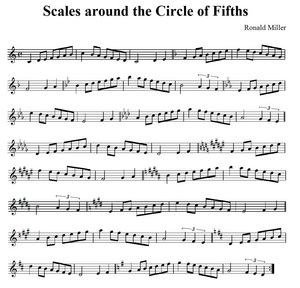No matter what type of music someone wants to play, one of the most important things to learn is the major scale in every key. A second thing to learn is the circle of fifths. The most common progression of keys is to go from one key to another key one fifth apart, such as going from C Major down a fifth to F Major. When doing this, the fourth step of the new key is lowered from the previous key. In the case of F, the B from the key of C becomes a Bb. Another way of saying this is that we can simply add one flat for the new key. When this is done, every key is visited until we return to the starting key of C. Halfway around this circle of keys (called the circle of fifths), notice that the key of F# is the same as the key of Gb.
The image at the top of this article has all twelve major keys written out with a few connecting notes between each scale. Click on it to enlarge it and print it out for practice. It is in a key suitable for treble clef woodwind instruments, such as clarinet, saxophone, flute, or oboe. The first and last few scales are easy, but it becomes difficult in the middle. The musician should take time to memorize each scale and to practice the difficult ones several times. In time, the musician will be able to play the entire circle of scales with ease.
This same circle of fifths has also been written for major chords in a previous article, Musicians Practice the Circle of Fifths (also by Ronald Miller at AssociatedContent.com). I suggest that you visit that article and print out the exercise there. The scales from this article match up with the chords of that exercise.
When you are able to play all of these scales smoothly, as they are written, I suggest that you add a few measures wherever you can. These are to be added wherever another octave of the scale will fit in the range of your instrument. For instance, all woodwinds would be able to add an octave going up on the C scale for measures 1 and 2. The saxophones and clarinet, but not the flute, will be able to add an octave going down and back up on the Bb scale, I would add that after measure 3 of line two.
Knowing all of the Major Scales by memory is important, so that you can read music in any key easily and also be able to improvise in any key. If you are interested in auditioning for a position in an all-state band or orchestra, you will probably be asked to play some scales at random. This also applies to applying as a music major at a college. Woodwind majors at colleges are typically required to memorize all Major Scales for the full range of their instrument in the first semester of woodwind lessons.





